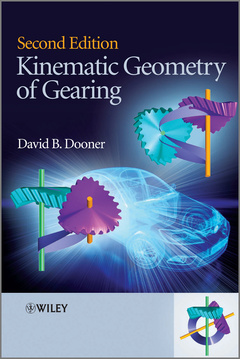Kinematic geometry of gearing (2nd Ed.)
Auteur : Dooner David B.

1.1 Introduction
1.2 An Overview
1.3 Nomenclature and Terminology
1.4 Reference Systems
1.5 The Input/Output Relationship
1.6 Rigid Body Assumption
1.7 Mobility
1.8 Arhnold-Kennedy Instant Center Theorem
1.9 Euler-Savary Equation for Envelopes (correct!, use arc-lengths)
1.10 Conjugate Motion Transmission
1.10.1 Spur gears
1.10.2 Helical and crossed axis gears
1.11 Contact Ratio
1.11.1 Transverse contact ratio
1.11.2 Axial contact ratio
1.12 Backlash
1.13 Special Toothed Bodies
1.13.1 Micro gears
1.13.2 Nano gears
1.14 Non - Cylindrical Gearing
1.14.1 Hypoid gear pairs
1.14.2 Worm gears
1.14.3 Bevel gears
1.15 Non-Circular Gears
1.15.1 Gear and cam nomenclature
1.15.2 Non-working profile
1.15.3 Rotary/translatory motion transmission
1.16 Schematic Illustration of Gear Types
1.17 Mechanism Trains
1.17.1 Simple drive trains
1.17.2 Epicyclic gear trains
1.17.3 Circulating power
1.17.4 Harmonic gear drives
1.17.5 Non-circular planetary gear trains
1.18 Summary
Part II
CHAPTER 2: KINEMATIC GEOMETRY OF PLANAR GEAR TOOTH PROFILES
2.1 Introduction
2.2 A Unified Approach to Tooth Profile Synthesis
2.3 Tooth Forms used for Conjugate Motion Transmission
2.3.1 Cycloidal tooth profiles
2.3.2 Involute tooth profiles
2.3.3 Circular-arc tooth profiles
2.3.4 Comparative evaluation of tooth profiles
2.4 Contact Ratio
2.5 Dimensionless Backlash
2.6 Rack Coordinates
2.6.1 The basic rack
2.6.2 The specific rack
2.6.3 The modified rack
2.6.4 The final rack
2.7 Planar Gear Tooth Profile
2.8 Summary
CHAPTER 3: GENERALIZED REFERENCE COORDINATES FOR SPATIAL
GEARING-THE CYLINDROIDAL COORDINATES
3.1 Introduction
3.2 Cylindroidal Coordinates
3.2.1 The special features of cylindroidal coordinates
3.2.2 The benefits of cylindroidal coordinates
3.3 Homogeneous Coordinates
3.3.1 Homogeneous point coordinates
3.3.2 Homogeneous plane coordinates
3.3.3 Homogeneous line coordinates
3.3.4 Homogeneous screw coordinates
3.4 Screw Operators
3.4.1 Screw dot product
3.4.2 Screw reciprocity
3.4.3 Screw cross product
3.4.4 Screw intersection
3.5 The Generalized Equivalence of the Pitch Point - The Screw Axis
3.5.1 The theorem of three axes
3.5.2 The cylindroid
3.5.3 Cylindroid intersection
3.6 The Generalized Pitch Surfaces - The Axodes
3.6.1 The theorem of conjugate pitch surfaces
3.6.2 The striction curve
3.6.3 The hyperboloid of osculation
3.7 The Generalized Transverse Surface
3.8 The Generalized Axial Surface
3.9 Summary
CHAPTER 4: DIFFERENTIAL GEOMETRY AND THE TOOTH SPIRAL
4.1 Introduction
4.2 The Curvature of a Spatial Curve
4.3 The Torsion of a Spatial Curve
4.4 The First Fundamental Form
4.5 The Second Fundamental Form
4.6 Principle Directions and Principle Curvatures
4.7 Torsure of a Spatial Curve
4.8 The Cylindroid of Torsure
4.9 Ruled Surface Trihedrons
4.10 Formulas of Fernet-Serret
4.11 Coordinate Transformations
4.12 Characteristic Lines and Points
4.13 Summary
CHAPTER 5: ANALYSIS OF TOOTHED BODIES FOR MOTION GENERATION
5.1 Introduction
5.2 Spatial Mobility...
David B Dooner is a Professor in the Department of Mechanical Engineering at the University of Puerto Rico-Mayagüez. He received his doctorate from the University of Florida at Gainesville in 1991 where he remained as a Post-Doctoral Fellow from 1991-1994. He worked at the General Motors Gear Center in 1989 and was a visiting scientist at the Mechanical Sciences Research Institute of the Russian Academy of Sciences in Moscow in 1992.
Date de parution : 04-2012
Ouvrage de 512 p.
17.4x25.2 cm
Disponible chez l'éditeur (délai d'approvisionnement : 12 jours).
Prix indicatif 147,55 €
Ajouter au panier